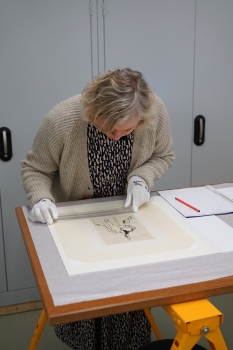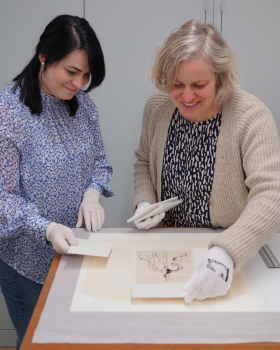My favourite word from my day-to-day work at the museum is “ausstellungsfein”: it means a work isn’t just exhibition ready, but “smart enough to show”. This word involves two wonderful aspects. On the one hand, the work has been smartened up, perhaps restored, and its frame touched up here or there: it’s ready for something new. On the other hand, the word indicates our growing anticipation. It means we’re preparing for a new exhibition and, once a work is “ausstellungsfein”, we can plan its inclusion in a show or even bring it out into an exhibition gallery that has already been prepared and painted.
For the first time, the exhibition Steamers, Dykes, Dramas: Prints from the Collection and Contemporary Positions opens up a broader and deeper look inside our collection of prints, systematically arranged according to style and subject matter. Here, the path to the status of “ausstellungsfein” was particularly intense and involved lots of planning.
Unlike our paintings, our prints are not attached to a frame when they are in storage; instead, whenever they aren’t on display, they’re placed in professional archival-quality boxes. These resemble artworks: they are handmade, covered with linen and include only materials that meet the most rigorous conservation standards. Their cardboard is acid-free and a special glue is used that is vapour free and doesn’t damage the paper, however fragile it might be.

Katrin Petersen beim Ausmessen von Emil Noldes Radierung „Dampfer“, 1910
For this exhibition of prints, we’re showing a very large number of works: over 130 sheets, to use the word preferred when dealing with works on paper, which applies to every single one of the pictures here – from the collection as well as by the contemporary artists. Of these sheets, 114 passed through our gloved hands, some of them multiple times, in the process of getting them “ausstellungsfein”. In sharp contrast to our previous exhibitions, which have typically presented paintings that were already framed, this involved taking a very, very great number of measurements. It was necessary to check the existing measurements and specify the dimensions of the openings in the mats. How much of the sheet should be seen? Do we want to make the imprint left by the printing plate visible? Perhaps a sheet of handmade paper displays an appealing edge that would enhance the sheet’s appearance?
These decisions were made individually for each work, in order to handle them appropriately in terms of conservation but also to present a picture in a particularly appealing way or to offer future viewers more insight into how an artist worked. Then we could determine a colour for the mat from a multitude of white and beige tones – and, finally, decide what size frame the work should be shown in.
When all these measurements and decisions had been taken and the mats we ordered had arrived, it was time for the painstaking and precise work of mounting the prints inside their new mats and then adding their frames. Here graduate trainee Sara Nina Strolo’s brilliant know-how in the field of art restoration became essential. She spent literally hours meticulously folding the charming little paper mounting corners which served to hold the sheets in place inside their mats.
Can you remember old photo albums whose interleaves resembled the waxed paper used to wrap sandwiches? They contain the same type of corners for mounting photos. This principle was also used for the works in the exhibition, so that none of the magnificent sheets had to be glued directly. Once the works had been attractively situated inside their mats by Sara Nina Strolo, they could be inserted into suitable frames and then take their place in the exhibition with the help of museum technician Uwe Jensen.

Sara Nina Strolo und Katrin Petersen beim Auswählen eines Farbtons für das Passepartout
Going to an exhibition and looking at the great variety of works there rarely enables us to get a glimpse of what lies behind it all. The selection processes, the considerations taken into account and the searches for similarities and contrasts remain hidden. The condition of the displayed works is also accepted as is by viewers – visitors to exhibitions are uncomplicated and easily satisfied in this respect. They usually don’t ask themselves whether too much varnish was added or whether a mat was made from acid-free paperboard. But maybe, after reading this contribution to our blog, you’ll have a different perspective on exhibitions and what lies behind them.
Katrin Petersen, M.A., Registrar / Research Associate
